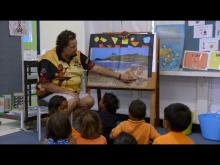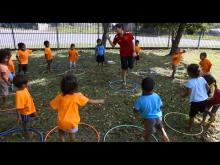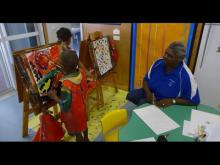"There are many ways of knowing and learning. I am keen to help encourage Indigenous children to find their voice through the power of music whilst strengthening an understanding about Indigenous ways of knowledge transfer." - Deborah Cheetham AO
Kalwun Early Learning Program
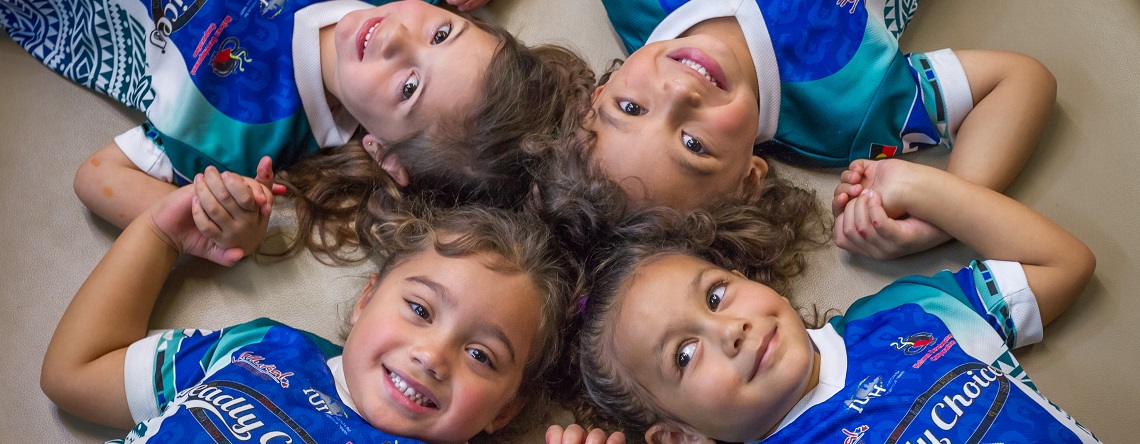
“There is quite a significant gap in the access to childhood services that Aboriginal and Torres Strait Islander kids have…we’re trying to close that gap." – Kirby Taylor, Kalwun Programme Manager
Find out more on the Kalwun Early Learning Program
A healthy start to life sets the foundations throughout the early years, giving children the best chance of succeeding at school and going on to follow their dreams throughout life. Evidence shows investment in the early years is one of the best ways to improve disadvantage over the longer term.
target
Halve the gap in mortality rates for Indigenous children
under five within a decade (by 2018).
- The target to halve the gap in child mortality by 2018 is not on track this year.
- However, over the longer term, Indigenous child mortality rates have declined and the gap has narrowed (between 1998 and 2015).
- There have been improvements in recent years in the proportion of Aboriginal and Torres Strait Islander mothers not smoking during pregnancy and a lower proportion of babies born with low birthweight.
- Better integration of services across health, childcare, early childhood education and school will result in better access to the right services.
- Intensive support for the children and families who need it most will ensure children have a good start to life.
National analysis
For the most part, the child mortality target has been on track in previous years. However, the 2015 Indigenous child mortality rate was slightly outside the range required for this target to be on track this year (see Figure). In part, the Indigenous child mortality trend has changed for this reporting period due to an improvement in the quality of Indigenous identification.1
Over the long-term (1998 to 2015), the Indigenous child mortality rate declined significantly (by 33 per cent). There was also a significant narrowing (31 per cent) of the child mortality gap. In the short-term, the decline in Indigenous child mortality rates between 2008 and 2015 was not statistically significant.
In the period 2011 to 2015, there were 610 Indigenous child deaths (0-4 years), of which 500 (or 82 per cent) were infant deaths (less than one year). The Indigenous infant mortality rate has more than halved from 13.5 per 1,000 live births in 1998 to 6.3 per 1,000 in 2015, and the gap has narrowed significantly (by 84 per cent) over this period.
Figure 1: Child mortality rates by Indigenous status: NSW, Qld, WA, SA and the NT combined, 1998 to 2018
.png)
View the text alternative for Figure 1.
The majority of Indigenous mothers (54 per cent in 2014) attended antenatal care in the first trimester of pregnancy and 86 per cent of Indigenous mothers attended five or more times during their pregnancy.2 From 2011 to 2014, the proportion of Indigenous mothers who attended antenatal care in the first trimester of pregnancy increased by 13 per cent.3 However in 2014, the age standardised proportion of Indigenous mothers who attended antenatal care in the first trimester was still lower than for non-Indigenous mothers (by 7 percentage points).4
There was a 13 per cent decline in the rate of low birthweight babies born to Indigenous mothers between 2000 and 2014. However, in 2014, the low birthweight rate among babies born to Indigenous mothers was still more than twice that of babies with non-Indigenous mothers (10.5 per cent compared with 4.7 per cent). Smoking during pregnancy continues to be a major factor contributing to the high rates of low birthweight among babies born to Indigenous mothers. While the proportion of Indigenous mothers who smoked during pregnancy declined from 54 to 46 per cent between 2006 and 2014,5 in 2014 the Indigenous rate was 3.6 times the non-Indigenous rate.6
State and Territory Progress
The child mortality target is only reported for the five jurisdictions for which Indigenous status data are of sufficient quality to publish (New South Wales, Queensland, Western Australia, South Australia and the Northern Territory). There is some variation by geography - New South Wales had the smallest Indigenous child mortality rate (111 per 100,000 population) and the smallest gap with non-Indigenous children (see Figure). The Northern Territory had the highest Indigenous child mortality rate (333 per 100,000) and the largest gap.
Figure 2: Child mortality rates (0-4 years) by Indigenous status: NSW, Qld, WA, SA and the NT, 2011-2015
.png)
View the text alternative for Figure 2.
National policy to drive improvement in child mortality outcomes
Our investment in the early years is twofold: improving integration of services across health, child care, early childhood education and school resulting in better access to the right services; and intensive support for the children and families who need it most.
In 2016, all governments collaborated on the National Framework for Health Services for Aboriginal and Torres Strait Islander Children and Families, which will guide development, implementation and evaluation of maternal, child and family health services. It focuses on pre-conception and maternity care services through to early childhood services for children up to eight years of age.
More information is available in the full Closing the Gap Prime Minister's Report 2017.
Local solutions
Supporting mothers and babies in Armidale
.jpg)
Armidale Aboriginal Mothers and Babies Service has been helping women through pregnancy and birth for over 10 years.
Find out more on the Armidale Aboriginal Mothers and Babies Service local solution
target
95 per cent of all Indigenous four year olds
enrolled in early childhood education (by 2025).
- There are strong links between participation in early childhood education and academic success.
- In 2015, 87 per cent of Aboriginal and Torres Strait Islander children in Australia were enrolled in early childhood education in the year before full-time school.
- Early childhood education programs for all children in the year before full-time school are a priority for all governments.
National analysis
The baseline for this target is 2015. In 2015, 87 per cent of Indigenous children were enrolled in early childhood education in the year before full time school, compared to the target benchmark of 95 per cent.7 Data to measure progress against this target will be available for next year’s report.
State and Territory Progress
In 2015, the information available suggests that all Indigenous and non-Indigenous children were enrolled in early childhood education in the year before fulltime school in Western Australia, South Australia and the Australian Capital Territory (see Figure).
Early childhood education enrolment rates for Indigenous children in the other states and territories were below the required benchmark of 95 per cent, although Victoria and Tasmania were very close.
Figure 3: Enrolment in early childhood education in the year before full-time school, by Indigenous status and state/territory, 2015 (per cent)2
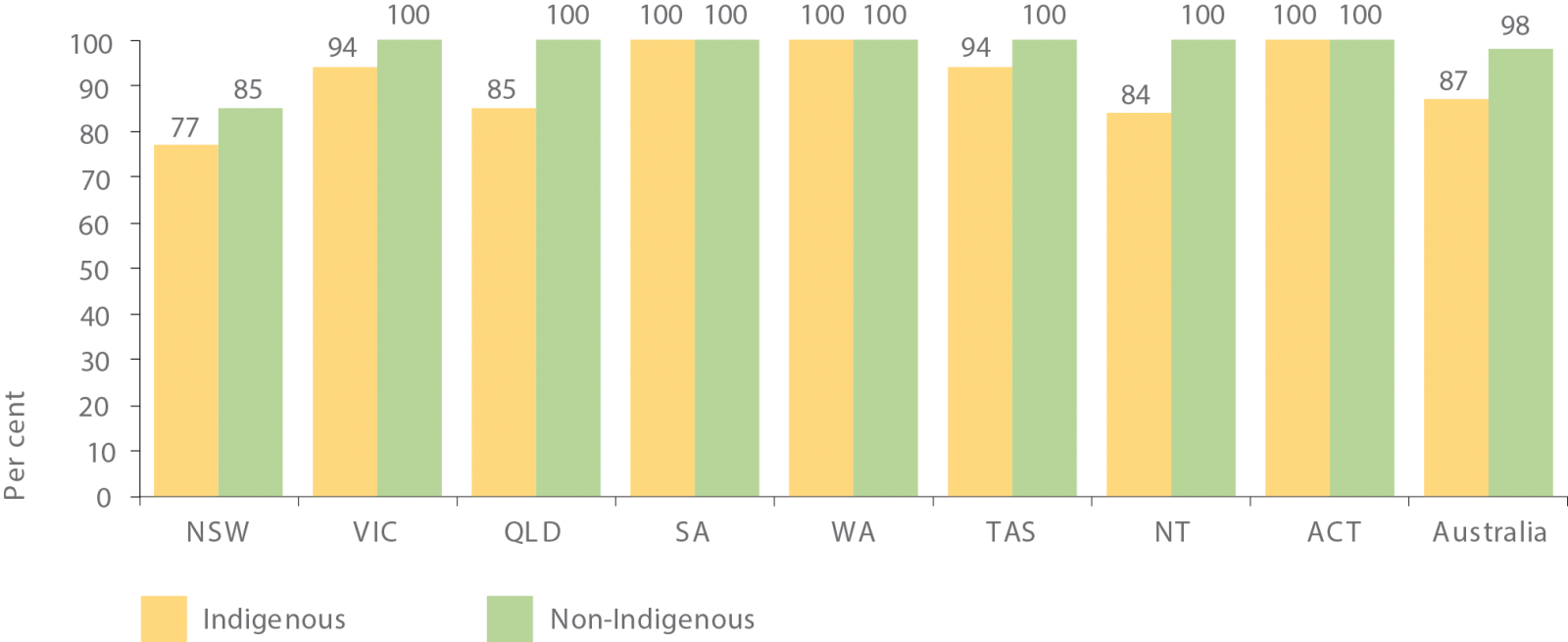
View the text alternative for Figure 3.
National policy to drive improvement in early childhood education outcomes
Early childhood education is a collaborative effort across all governments. Under the National Partnership Agreement (NPA) on Universal Access to Early Childhood Education, the Commonwealth is providing over $840 million over 2016 and 2017 to states and territories to ensure every Australian child has access to quality early childhood education programs for 15 hours per week in the year before formal school, regardless of the setting. The agreement has a strong focus on participation by Aboriginal and Torres Strait Islander children.
Better integration of services has been identified as an effective way to improve support for vulnerable children and families. From 2016-17, the Government is investing $10 million annually through the Community Child Care Fund to integrate early childhood, maternal and child health and family support services with schools in a number of disadvantaged Indigenous communities. The focus is on supporting Aboriginal and Torres Strait Islander families so their children make a positive transition to school.
More information is available in the full Closing the Gap Prime Minister's Report 2017.
Local solutions
Wiradjuri learning in Tumut, NSW
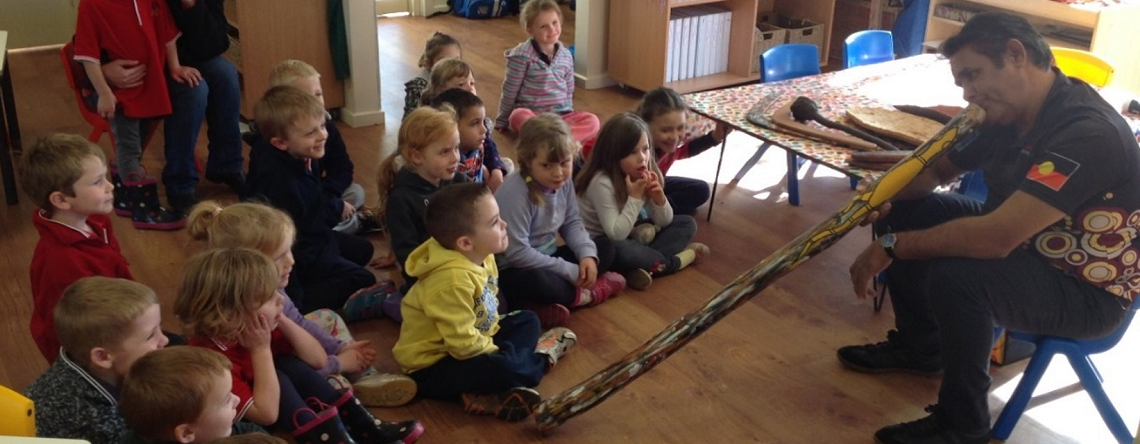
“We have over 200 learning games for the children that are simple to play but help develop vital learning skills the children will need when they transition to school." - Julie Christine, Coordinator, Gumala Aboriginal Corporation
Find out more on the Wiradjuri learning local solution
More local solutions are available on the resources page
[1] For 2015 data, the Queensland Registry of Births, Deaths and Marriages included Medical Certificate of Cause of Death information for the first time to contribute to the Indigenous status data item. This was associated with a decrease in the number of deaths for which the Indigenous status was 'not stated' and an increase in the number of deaths identified as Indigenous in Queensland. Although the Indigenous child mortality rate was higher in Queensland in 2015, for New South Wales, Western Australia and South Australia the rates were lower in 2015 than in 2014. This change in method means that time series data are not directly comparable and caution should be used in interpreting the trend. In 2015, there were 124 Indigenous child deaths. This was four deaths outside the range of the target and an increase of six deaths since 2014.
[2] Aboriginal and Torres Strait Islander women who gave birth at 32 weeks or more gestation, NSW, Queensland, SA, WA, Tasmania, NT and ACT. These data are not generalizable to Australia
[3] Age standardised data. This time series excludes data from NSW due to a change in data collection practices from 2011.
[4] Comparisons between Indigenous and non-Indigenous mothers are age standardised to account for the different age profiles of the two populations.
[5] Trends exclude Victoria as data were not available for Victoria before 2009.
[6] Comparisons between Indigenous and non-Indigenous mothers are age standardised to account for the different age profiles of the two populations.
[7] A revised method was developed to address numerator and denominator misalignment for age and location, removing children already in school from the denominator, and adjusting for Indigenous status not stated. It is considered a significant improvement, but there are some further potential sources of difference between the early childhood education numerators and the population denominators that may impact on the accuracy of the estimates.
[8] Proportions are over 100 per cent but displayed as 100 per cent for the following: Indigenous children in WA (105 per cent); SA (112 per cent); and ACT (124 per cent). Non-Indigenous children in Vic. (103 per cent); QLD (108 per cent); WA (101 per cent); SA (103 per cent); Tas. (102 per cent); ACT (109 per cent); and NT (106 per cent).
Source: ABS unpublished, Preschool Education, Australia 2015; Australian Demographic Statistics, June 2015; Births, Australia, 2015; Estimates and Projections, Aboriginal and Torres Strait Islander Australians, 2001 to 2026; Schools, Australia 2015.

